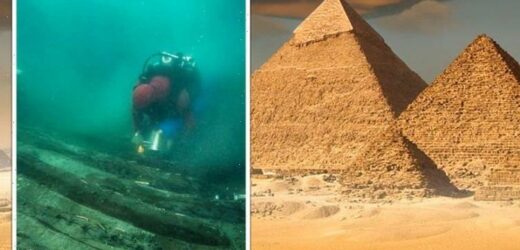Egypt: Archaeologists discover traces of pharaoh Khufu
We use your sign-up to provide content in ways you’ve consented to and to improve our understanding of you. This may include adverts from us and 3rd parties based on our understanding. You can unsubscribe at any time. More info
Divers found the wreck of the ancient Egyptian galley at the site of Thonis-Heracleion – a 3,000-year-old city that was discovered in 2011 filled with artefacts from everyday life, as well as some unusual human and animal remains. The settlement is believed to have sunk at the end of the second century BC, following a combination of earthquakes, tsunamis, rising sea levels, and soil liquefaction. And it is still revealing its secrets – experts from the Egyptian-French mission led by the European Institute for Underwater Archaeology (IEASM) have discovered the rare remains of a military vessel.
They believe the ship sank when the famed temple of Amun it was mooring next to collapsed in the second century BC.
According to Egypt’s Tourism and Antiquities Ministry, a preliminary study shows the hull of the 25-metre flat-bottomed ship, with oars and a large sail
In another part of the city, the mission revealed the remains of a large Greek funerary area dating back to the first years of the fourth century BC.
A statement read: “This discovery beautifully illustrates the presence of the Greek merchants who lived in that city.


“They built their own sanctuaries close to the huge temple of Amun. Those were destroyed, simultaneously and their remains are found mixed with those of the Egyptian temple.”
Lead researcher and president of the European Institute for Underwater Archaeology, Franck Goddio, said in a statement that the finds of fast galleys from this period are “extremely rare”.
It is one of only two surviving vessels known to have been built this way – the first, the Marsala, built in 235 B.C., was discovered in 1971 in Sicily, according to Artnet.
The discovery of the wreck, along with the remains of a funerary area, was found using a new type of SONAR.

In the funerary area, experts uncovered elaborate pottery and a gold amulet of the Egyptian god Bes, often associated with childbirth, fertility, sexuality, humor and war.
The area is believed to have been the centre of Mediterranean trade more than 1,000 years ago.
Before Alexandria was founded by Alexander the Great in 331, Thonis-Heracleion was the largest port city in Egypt.
Mentioned by many chroniclers in antiquity, including Herodotus, the lost city was said to have been visited by the mythical Greek legends of Alexander and Helen of Troy during the Trojan War.
DON’T MISS
End of the world: How archaeologist discovered ‘real Maayan doomsday’ [VIDEO]
Mayan discovery: How find in ancient city ‘reveals creation story’ [CLAIM]
Egypt: How ‘greatest archaeological find of all time’ stunned expert [REVEALED]


They sought refuge from the Pharaoh after their flight from the jealous Menelaus but were rebuffed by Thonis, the watchman at the entrance to the Nile.
According to accounts, a great temple was built at the spot where Heracles first arrived in Egypt, renaming the Egyptian town of Thonis to become the mythical Heracleion.
Before the 2011 find, all physical traces of the city had seemingly been wiped off the map, leading experts to believe it was just an ancient myth.
Source: Read Full Article


